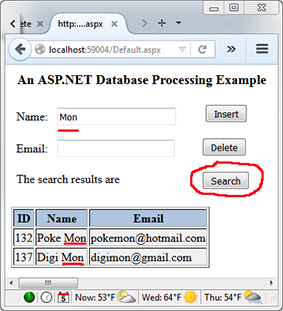<%@ Page Language="C#" AutoEventWireup="false"
CodeDatabase="Default.aspx.cs" Inherits="_Default" %>
<!DOCTYPE html>
<html xmlns="http://www.w3.org/1999/xhtml">
<body>
<form id="form1" runat="server">
An ASP.NET Database Processing Example
Name: <asp:TextBox ID="authorName" runat="server" Width="150px" />
Email: <asp:TextBox ID="email" runat="server" Width="150px" />
<asp:Button ID="insert" runat="server" Text="Insert" />
<asp:Button ID="delete" runat="server" Text="Delete" />
<asp:Button ID="search" runat="server" Text="Search" />
The search results are
<asp:Repeater ID="searchResult" runat="server">
<HeaderTemplate>
<table border="1">
<tr bgcolor="#b0c4de">
<th>ID</th><th>Name</th><th>Email</th>
</tr>
</HeaderTemplate>
<ItemTemplate>
<tr bgcolor="#f0f0f0">
<td><%#DataBinder.Eval(Container.DataItem,"authorID")%></td>
<td><%#DataBinder.Eval(Container.DataItem,"authorName")%></td>
<td><%#DataBinder.Eval(Container.DataItem,"email")%></td>
</tr>
</ItemTemplate>
<FooterTemplate></table></FooterTemplate>
</asp:Repeater>
</form>
</body>
</html>
|
